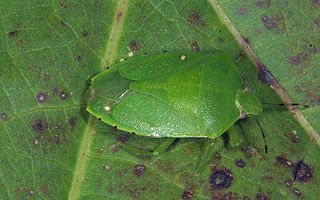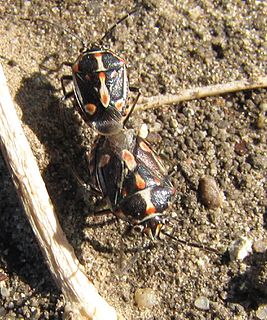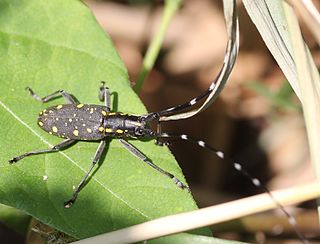
Convolvulaceae, known commonly as the bindweed or morning glory family, is a family of about 60 genera and more than 1,650 species of mostly herbaceous vines, but also trees, shrubs and herbs, and also including the sweet potato and a few other food tubers.

Pentatominae is a subfamily of Pentatomidae, a family of shield bugs. This subfamily is the largest one within the pentatomidae, having 4937 species. classified in 938 genera. Species on this subfamily are phytophages and several of them have been considered agricultural pests. Some invasive pentatomines such as Halyomorpha halys and Bagrada hilaris have been considered household pests, even inflicting adventitious bites. Higher systematics of the group has been revised by Rider et al.

The green stink bug or green soldier bug is a stink bug of the family Pentatomidae.

Stenochironomus is a genus of European non-biting midges in the subfamily Chironominae of the bloodworm family Chironomidae.

Junonia genoveva, the mangrove buckeye, is a butterfly of the family Nymphalidae. The species was first described by Pieter Cramer in 1780. It is found in North America from southern New Mexico, southern Arizona, southern Texas, and southern Florida south through the West Indies, Mexico and Central America to Argentina. Rare strays can be found up to southeastern California, southeastern Colorado and central Florida. In the Cayman Islands, it is known as the Caribbean buckeye.

Bagrada hilaris is a species of shield bug known by the common names bagrada bug and painted bug (See a short video at YouTube). It could be mistaken for or erroneously referred to as harlequin bug. It is native to Africa. It is known elsewhere as an introduced species, including California and Arizona, where it was first reported in 2008. It is a major pest insect of Brassica oleracea crops, and related crucifers such as turnips, rape, and mustard. The adult and nymph of the species suck sap from the leaves of the plants, causing wilting, yellowing, and stunting of growth. Besides crucifers, the bugs are known on papaya, sorghum, maize, potato, cotton, caper, pearl millet, and some legumes. Large numbers of the bug congregate on the plants and cause extensive damage.

Sant Hilari Sacalm is a municipality in the comarca of the Selva in Catalonia, Spain.

Zygaena hilaris is a species of moth in the family Zygaenidae.
Hylaeus hilaris is a species of bee, also known by the common name hilaris yellow-faced bee. It is endemic to Hawaii and known only from a single population. In September 2016, along with six other Hawaiian Hylaeus species, H. hilaris was listed for protection under the United States Endangered Species Act. This marked a first listing for any bee species in the US.

The Yellow spotted longicorn beetle is a species of beetle in the family Cerambycidae. It was described by Francis Polkinghorne Pascoe in 1857. It is known from North Korea, China and Japan. It has been introduced to Italy.
Caenis hilaris is a species of small squaregilled mayfly in the family Caenidae. It is found in North America.
Stenochironomus macateei is a species of midge in the family Chironomidae.
Stenochironomus woodi is a species of midge in the family Chironomidae.
Stenochironomus colei is a species of midge in the family Chironomidae.
Stenochironomus pulchripennis is a species of midge in the family Chironomidae.

Pandeleteius hilaris is a species of broad-nosed weevil in the beetle family Curculionidae. It is found in North America.
Stenochironomus poecilopterus is a species of midge in the family Chironomidae.

Fyning Moor is a 12.8-hectare (32-acre) biological Site of Special Scientific Interest south of Fyning in West Sussex.

Anoteropsis hilaris, commonly referred to as the garden wolf spider, is a species of wolf spider that is endemic to New Zealand.

Chinavia is a genus of green stink bugs in the family Pentatomidae. There are more than 30 described species in Chinavia.













